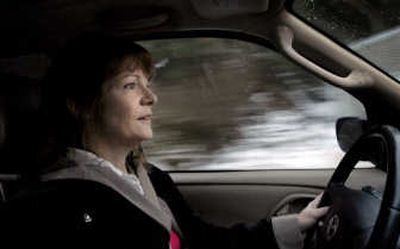Area motorists prep for winter weather

When Bob and Eileen Mouzoon recently moved to Hayden Lake from Orange County, Calif., they got more than a forested view and their own boat slip. They also got their first Northwest winter.
Snowstorms, power outages and icy roads greet hundreds of transplants who move to North Idaho and Eastern Washington each year seeking beauty, recreation and a change from the city.
“I’ve been in falling snow once before this,” said Eileen Mouzoon, 49. “It was at Mount Rushmore in May, so it was very light.”
Preparing for winter in Southern California meant getting a sweatshirt from the closet. Now Mouzoon favors long underwear, wears boots and is searching for gloves that actually keep her fingers warm.
Even with a four-wheel drive vehicle and siped, all-season tires, learning to navigate the narrow and winding east Hayden Lake Road hasn’t been as easy as ordering wool clothes from L.L. Bean. The scariest part of the trip is before Mouzoon even leaves home: backing out of her garage onto the steep, icy driveway.
“I know other people are a lot more confident than I am and tend to go faster,” she said on a recent drizzly December day, steering her Mazda Tribute down the waterfront route.
Northwest natives often disdain newcomers, especially those with California plates. There are jokes and bumper stickers about praying for a heavy snow year to drive transplants back to their southern homes. Mouzoon has heard it all and finds solace in her Idaho license plates.
Marte Cliff, of Priest River, Idaho, has spent 60 winters in the snow. In response to an e-mail survey sent to readers, Cliff gave this advice:
“Leave home early and slow down,” she wrote. “Too many of our newcomers think that just because they have four-wheel drive, snow tires, or studs they can safely drive just as if they were on a dry California freeway and it just isn’t so!”
Roger Lyle, of Davenport, offered another suggestion.
“Pretend you are a goose and go South for the winter,” he wrote, admitting he spent the snow season in Arizona for 15 years.
Troopers from both the Idaho State Police and Washington State Patrol agree that it’s a myth to blame “California drivers” for the majority of winter accidents.
“It can sneak up on anybody,” said WSP Trooper Jeff Sevigney. “People don’t prepare themselves mentally or they are in too much of a hurry. It’s wintertime in the Northwest. You just never know what could occur out there.”
That’s why the ISP developed a free winter driving course. Sgt. Jonelle Greear said about 5,000 people of all ages, including local driver education students, have attended in the past five years. Insurance companies often give participants up to a 10 percent discount on premiums, she said. Washington doesn’t offer a similar course.
The state police encourage everyone to take the three-hour class, not just newcomers. Greear said even natives can use a refresher.
“We want to reach as many drivers as we can,” Greear said. “We would rather see them in the classroom than upside down in the ditch.”
Eileen Mouzoon took the course and is building her confidence by remembering the common-sense basics: leave early, slow down, leave room between you and the vehicle in front of you, and wear your seat belt.
Troopers also teach that four-wheel drive doesn’t mean drivers can go 65 mph when Interstate 90 is layered in compacted snow.
“Folks in SUVs often get a little bit of a false sense of security,” Sevigney said.
The reality is that four-wheel drive just helps vehicles get going, but it has no ability to help vehicles stop, especially on ice.
“If you are driving with all-wheel drive or four-wheel drive you still need to slow down,” he said. “That’s the biggest problem we see.”
Winter driving isn’t the only concern for newcomers. Blustery weather also results in power outages and ice storms.
The Mouzoons have already lost power once, but the electricity came back before the couple had any hardship.
“Every year now people move here and might not realize what they are up against,” said Sandy Von Behren, director of the Kootenai County Office of Emergency Management.
The office offers a plethora of information, including pamphlets outlining safety tips for winter storms. (Among the tips: Create a disaster supply kit, which can sustain a family for three days if the power goes out. The six basic necessities: water, food, first aid supplies, clothing and bedding, tools and special items such as important family documents or medications.)
The Kootenai county office also directs people to the Federal Emergency Management Agency’s free guide to preparedness, “Are you Ready,” which is available at www.fema.gov. Coeur d’Alene Fire Chief Kenny Gabriel is concerned about how people heat their homes if the power goes out, especially after a recent spike in carbon monoxide poisonings in the region.
“Don’t bring your barbecue inside,” he said. “Do not do it, no matter what.”
Instead of risking exposure to the difficult-to-detect and deadly gas, he recommends buying a UL-approved generator to put outside. Gabriel said residents also should store fuel outside.
Another mistake people make is putting ash from wood stoves in plastic garbage bags inside their garages. The ash is often still flammable and can ignite house fires, Gabriel said.
People should dispose of ash in metal containers with metal lids and keep it outside.